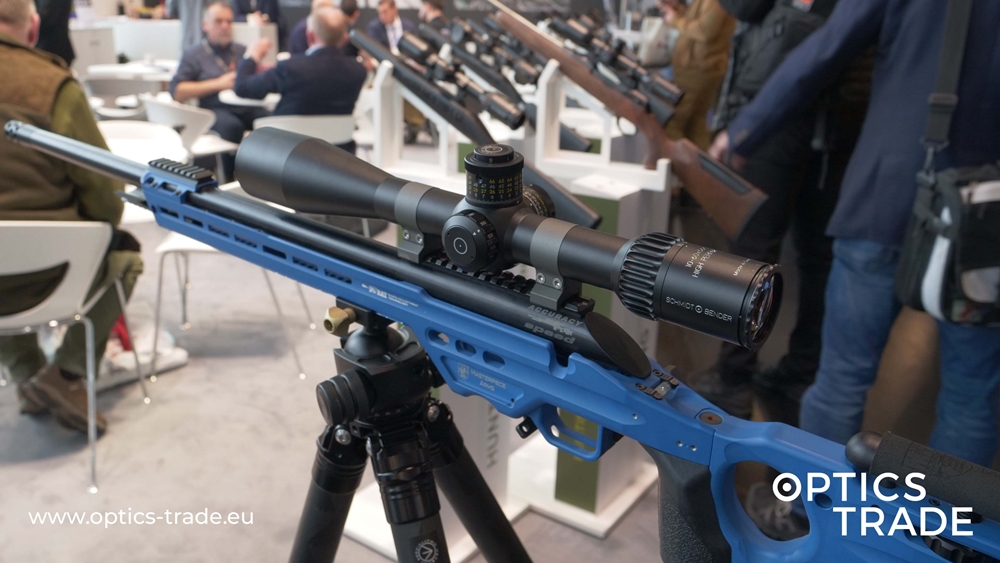Welcome to Optics Trade debates. In each episode, we talk about a different topic and try to answer the most common questions we receive about it. Today, we are going to be talking about windage range and elevation range.
Windage and Elevation Range Video
What is windage and elevation?
Windage and Elevation range are one of the basic parameters found in the tables of our webstore. These two parameters define the total elevation (up, down) and total windage (right, left) travel that a scope has. The elevation and windage is basically the total travel of the reticle when being zeroed.
These two parameters are usually measured in one of the three different units:
- MIL/MRAD
- MOA
- cm/100 m
Elevation and Windage on Tactical Rifle Scope
They’re usually measured in milliradians (mil, mrad) on tactical scopes. If the total internal elevation is 35 mrad, the elevation on 100 m is about 3.5 m. Tactical scopes are also used on a long range and that’s why the total elevation is really important because it affects the maximum distance at which it’s still possible to hit a target. Tactical scopes should have at least 20 clicks, the more the better. For long range shooting the only usable elevation is downwards.
Elevation and Windage on Target and Hunting Rifle Scope
On target scopes it’s usually measured in Minutes Of Angle (MOA). If a target scope has 60 MOA elevation adjustment, and 40 MOA of windage, the elevation range is about 1.7 m and the windage range is about 1.2 m on a ranges of 100 m.
In most target scopes and especially European hunting scopes, they are defined by cm/100 m. This is the most simple method and is found mostly in Europe.
Elevation doesn’t really matter on hunting scopes, because it is enough if you have more than 1 m of elevation. Some hunting scopes have only 60 m of windage and because of that, the mounting solution needs to be good enough to fit in that range so that it can be zeroed.
Is windage adjustment left or right?
Windage is how much right and left you can adjust the reticle. For example, if you see in rifle scope specifications windage is 1.5 m / 100 m, this means that you can adjust the reticle maximal 0.75 m right and maximal 0.75 m left for hits on your target at 100 m. Windage range is usually specified in MRAD (1 mrad is 10 cm / 100 m) or MOA (1 MOA is 2.9 cm / 100 m). Some manufacturers designate MRADs with an acronym MIL.
This is a necessary function for zeroing the rifle scope since with this feature you can eliminate any misalignment with your weapon, and adjust the reticle exactly on the point of impact of your ammunition.
With windage adjustment, we can also compensate wind drift of the bullet from a straight trajectory. Wind drift is caused by the effect that a side wind has on a bullet.
Practically all newer rifle scopes have the possibility to adjust the reticle left or right (windage) and up or down (elevation). This process is known as zeroing. The upper turret on rifle scope is for elevation adjustment of reticle and side turret on rifle scope is for windage adjustment of the reticle. Hunter rifle scopes have the mechanism of both turrets protected with caps which protect turret from water, damage or any other outside impacts. Turrets are in other words rotatable buttons which you can spin in in both directions.
Every single movement made with the turret produces a »click« sound. Usually, 1 click on European rifle scopes moves hit on target for 1 cm at 100 m range (0.1 MRAD / MIL). On American, Japanese and Chinese scopes 1 click moves the hit on the target for ¼ MOA (minute of angle) which is 7 mm at 100 m range. On Benchrest of F-class rifle scopes, where the corrections have to be very small and precise, the clicks are in 1/8 MOA (3,5 mm / 100 m) or 0.05 MRAD (5 mm / 100 m).
What is elevation adjustment?
The elevation is how much up and down you can adjust reticle. For example, if you see in rifle scope specifications elevation is 3.5 m, this means that you can adjust reticle maximal 1.75 m up and maximal 1.75 m down for hits on your target at 100 m. Elevation range is usually specified in MRAD (1 mrad is 10 cm / 100 m) or MOA (1 MOA is 2.9 cm / 100 m). Some manufacturers designate MRADs with an acronym MIL.
Practically all newer rifle scopes have the possibility to adjust reticle left or right (windage) and up or down (elevation). This process is known as zeroing. The upper turret on a rifle scope is for elevation adjustment of reticle and side turret on rifle scope is for windage adjustment of reticle. Hunter rifle scopes have the mechanism of both turrets protected with caps which protect turret from water, damage or any other outside impacts. Turrets are easily set with rotatable buttons which you can spin to the left or to the right.
Every single movement made with the turret produces a »click« sound. Usually, 1 click on European rifle scopes moves hit on target for 1 cm at 100 m range (0.1 MRAD / MIL). On American, Japanese and Chinese scopes 1 click moves the hit on the target for ¼ MOA (minute of angle) which is 7 mm at 100 m range.
For long range shooting elevation of at least 2.6 m / 100 m (26 MRAD or 89 MOA) is needed.
Conclusion
We would like to thank you for your time. In case we did not answer all the questions regarding this topic, please leave a comment below or send an e-mail to us. If you found this video useful, please subscribe to our channel.





Why turret knobs move the reticle in opposite directions rather than etched knobs given directions? Because public will think that the product is defective it doesn’t make sense as why it moves in opposite directions because we have to align the reticles POA with POI.